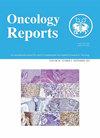Mouse macrophage metalloelastase generates angiostatin from plasminogen and suppresses tumor angiogenesis in murine colon cancer.
IF 3.9
3区 医学
Q2 ONCOLOGY
引用次数: 22
Abstract
Previous studies showed that the mouse macrophage metalloelastase (MME) generates the angiogenesis inhibitor angiostatin from plasminogen in vitro. This study aimed to determine whether tumor cells engineered with MME could generate angiostatin and suppress tumor angiogenesis in vivo. Murine CT-26 colon cancer cells stably transfected with MME were inoculated subcutaneously. A radioisotope tracer, immunoblotting, immunofluorescence and immunohistochemistry were used to explore the pathway of the angiostatin generation. The results showed that tumors derived from MME-transfected cells demonstrated a less microvessel density compared with control tumors derived from vector-transfected and non-transfected cells (P<0.001). The expression of vascular endothelial growth factor (VEGF) was significantly lower in the MME-transfected group compared with that of the controls. The growth of MME-transfected tumors was significantly retarded compared with the control tumors (P<0.001). Western blot analysis, using a specific anti-mouse plasminogen (1-4 Kringle) antibody, demonstrated two strong immunoreactive bands (38- and 35-kDa) in MME-transfected tumors. gamma-ray counting data demonstrated that plasminogen cleavage occurred mostly in tumors formed by cells forced to express. We concluded that MME was demonstrated to be an efficient angiostatin-producing MMP and its presence was negatively correlated with the growth of colon cancer in tumor-bearing mice. These findings provide direct evidence that MME generates angiostatin in tumor-bearing mice and the therapeutic application of MME against tumors.小鼠巨噬细胞金属弹性酶从纤溶酶原产生血管抑制素并抑制小鼠结肠癌肿瘤血管生成。
先前的研究表明,小鼠巨噬细胞金属弹性酶(MME)在体外由纤溶酶原产生血管生成抑制剂血管抑制素。本研究旨在确定MME工程肿瘤细胞是否能在体内产生血管抑制素并抑制肿瘤血管生成。皮下接种经MME稳定转染的小鼠CT-26结肠癌细胞。采用放射性同位素示踪、免疫印迹、免疫荧光和免疫组织化学等方法探讨血管抑制素的生成途径。结果显示,与载体转染和未转染细胞的对照肿瘤相比,转染mme细胞的肿瘤微血管密度更低(P<0.001)。与对照组相比,mme转染组血管内皮生长因子(VEGF)表达明显降低。与对照组相比,转染mme的肿瘤生长明显迟缓(P<0.001)。使用特异性抗小鼠纤溶酶原(1-4 Kringle)抗体的Western blot分析显示,在mme转染的肿瘤中存在两条强免疫反应带(38-和35-kDa)。伽马射线计数数据表明,纤溶酶原切割主要发生在由细胞被迫表达形成的肿瘤中。我们得出结论,MME被证明是一种有效的产生血管抑制素的MMP,它的存在与荷瘤小鼠结肠癌的生长呈负相关。这些发现为MME在荷瘤小鼠体内产生血管抑制素以及MME对肿瘤的治疗应用提供了直接证据。
本文章由计算机程序翻译,如有差异,请以英文原文为准。
求助全文
约1分钟内获得全文
求助全文
来源期刊

Oncology reports
医学-肿瘤学
CiteScore
8.50
自引率
2.40%
发文量
187
审稿时长
3 months
期刊介绍:
Oncology Reports is a monthly, peer-reviewed journal devoted to the publication of high quality original studies and reviews concerning a broad and comprehensive view of fundamental and applied research in oncology, focusing on carcinogenesis, metastasis and epidemiology.
 求助内容:
求助内容: 应助结果提醒方式:
应助结果提醒方式:


